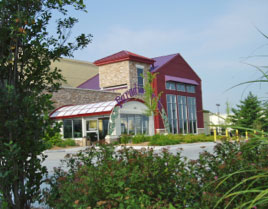An early version of this article was published in the February-March 2012 issue of the Leisure eNewsletter.
Getting family entertainment center architectural design right the 1st time for maximum profitability
Over the past twenty-three years we have discussed in our newsletters, blogs and lectured on at conventions and seminars the many factors that need to considered in the architectural and interior design of location-based entertainment facilities (LBEs), including family entertainment centers (FECs), bowling centers and children’s entertainment/edutainment centers. The design of the physical facility has a profound impact not only on the cost of the project, but just as, if not more importantly, on the quality of the guest experience, directly impacting revenues and the cost efficiency of operating the business. In other words, design directly affects:
- Development cost
- How much your guests enjoy the experience of visiting
- How long they stay
- How much they spend
- Whether and how often they return
- What it costs to operate the business
- Profitability and return on investment
Most design decisions are permanent, or at the very least, costly to correct if they can be corrected. In most cases, the cost of developing a center with a flawed design is the same as developing one with a good design. So getting the design right in the beginning is very important to long-term success and profitability.
Yet as critical as good design is to success, many LBE developers continue to make multiple design errors that permanently handicap their opportunity for profitability, and in some cases, threaten their very survival. In our travels throughout the world, we have probably seen several 1,000 family entertainment centers (FEC) of all types. We continue to see the same major design errors repeated. What causes so many owners of these centers to get it wrong?
In most cases the problem is not intentional. In fact, the owners are following what they believe to be the correct approach, the conventional wisdom of hiring a local architect to design the center. Unfortunately, this choice is the root cause of the problem and the result of a myth created and perpetuated by the architecture profession- the myth that any architect is qualified to design any type of facility. This is basically equivalent to the idea that any doctor is qualified to treat any type of ailment or disease or to perform any type surgery. Just as medicine has its specializations, so too, is specialization required for designing different type business facilities such as FECs and bowling centers. Other examples of specialized facilities that require design expertise include sports stadiums, hospitals, biotech labs, childcare centers and airports. Before we have architects writing us about this observation, we want to acknowledge that there are architects who are the exception. Although in the minority, there are ethical architects who will not take on an assignment from a client for a specialized building type they do not have the required experience and expertise to design.

Unfortunately, most architects will accept any design assignment despite their lack of training, experience and expertise in the particular business and facility type. This has become even more prevalent during the current economic turndown, as the severe slowdown in new construction has many architects scrounging for work. When it comes to offices or warehouse space, the required expertise is minimal, as these are really buildings, not businesses. But when it comes to specialized facilities, like family entertainment centers or bowling centers, the design is much more than just the design of a building; it is the design of a business.
What typically happens in the development process is that an entrepreneur FEC developer will find an architect in the local area and hire that individual to handle the architectural design. And rarely will the architect say, "Sorry, but I am not really qualified to do this for you. This is a very specialized type of facility, and I don't have the expertise to do a good job for you." Imagine going into your general practitioner doctor or internist and asking him or her to perform heart surgery on you. Yet most LBE developers basically do the equivalent when they hire local architects.
Architects, especially younger firms trying to get established and gain business, often use a marketing ploy that helps reel in the unsuspecting entrepreneur. They offer to do some initial preliminary design work for FREE. This is known in the industry as doing work on the come. Most entrepreneurs want to minimize their upfront expenditures until they get required zoning and financing, so the idea of getting preliminary design work for free has great appeal. But because the work is unpaid, the architect may very well not invest the amount of time and effort that would go into paid work. So what the entrepreneur ends up with is a preliminary design for an FEC by an architect who doesn't know what good FEC design is and who probably has expended only minimum effort. It's back to the old maxim: you only get what you pay for.
What happens next is the fatal pitfall. The entrepreneur gets the required zoning and financing and proceeds with the project design that is now basically cast in stone. And of course, the entrepreneur hires the same architect, feeling obligated for all the "great work" that was done for free (oh, if they only knew!).
It's not over yet, though. The architect is now in charge of the design, and because architects tend to have large egos when it comes to their designs, any suggestions on how to improve or correct the design falls on deaf ears (the architect's). Furthermore, because the zoning approvals and financing were based upon the original preliminary design, changing any basics in the design becomes very difficult, if not impossible.

Another sales pitch technique architects sometimes use to seduce FEC entrepreneurs into their fold is to tout how "creative" their designs are. They will show the entrepreneur great looking photos of their projects and will brag about the awards they have won for their creative designs. This all sounds great on the surface, but in our experience, "We are very creative" typically translates to: "We don't know anything about your project type, but we are sure we can find a creative design solution that is neither based on past experience, what has been proven to work in the industry nor will generate the most business for you. But with the right photographer, we can win a design award with it." Whenever you hear an architect or other designer bragging about how creative he or she is, run for the hills, as creativity doesn't usually translate into business success and profits.
Some architects try to overcome their lack of expertise in FEC design by telling the developer they will find an industry consultant to help them, thus implying that the design will in fact be based on industry expertise. This is the same technique many architectural firms use to win a request for qualifications (RFQ) or a request for proposal (RFP). They find some industry expert to add to their team in order to borrow that person’s expertise to gain credibility as experts in that project type. Unfortunately, this rarely if ever results in the best design. When it comes to a business such as an FEC, the devil is in the details, hundreds of them. There are many design decisions that have to be made, and each one has an impact on many others. Just having a consultant give occasional input, which is about as often as an architect will seek it, doesn’t result in a very complex set of design considerations coming together in a good design. As the architect works on the design, he isn’t even aware of all the considerations unless the consultant is continuously looking over his shoulder, which never occurs. The architect doesn’t know what he doesn’t know. The other problem with this approach is the ego of most architects. Too often, no matter what the consultant tells them, the architects still design the way they think is right. So the consultant’s knowledge and expertise never gets fully reflected in the design.
There’s one more issue with most architects. Architects are trained to design buildings and the primary factors that impact their design are concerns such as building codes and structural and mechanical system considerations. Of course these are important design considerations. But a FEC’s guests are also, if not more so, affected by the emotional, aesthetic and comfort qualities of the interior design and its furnishings. This is something that interior designers, not architects, are specialists in. Most smaller architectural firms do not have interior designers, so the architect is in charge of the interior design and furniture selection. And for the larger firms that do have staff interior designers, all too often the architects still run the show.
So what's the solution for entrepreneurs who are developing LBEs such as family entertainment centers? The answer is not all that complicated. Hire any of the number of design firms that specialize in the design and development of FECs. Firms that specialize in indoor facilities are more limited, but they are out there. No, none of these firms will do upfront work for free in hopes the project will move forward and the firm will get the full design contract. As specialists, their services are in demand. They deliver value, and they will charge you for their work. The bottom line is if you hire a specialist, you will get a project that will maximize profits rather than one that has built-in handicaps.
Our firm takes the approach of producing FECs and other type LBEs for our clients rather than just designing them. All aspects of the business and the design of the facility are totally interdependent, which is why we use a coordinated and integrated process to design the entire business, rather than to design just the building. Our experienced production team is managed by the principal of our company who has over 23-years’ experience and knowledge of all aspects of FEC feasibility, operation, management, marketing and economics, as well as design. Our production team includes architects, who are very important team members, but the architects do not oversee the process. They are just one of many designers on the team. Our production team also includes interior designers who understand the emotional and psychological aspects of interior design, landscape architects, civil engineers, caricature artists, sign designers, kitchen designers, restaurant experts, acoustic engineers, equipment specialists, child development experts and many other specialized designers.
Our production team has worked throughout four continents in 32 countries over the past 23 years. In the United States, where sealed architectural, civil engineering, mechanical, electrical and plumbing engineering and landscape architectural drawings are normally required, we are either licensed or qualified to obtain licenses in nearly every state.
For international FEC work, we team up with local architects and engineers, but maintain control of the entire design. We develop what are called design intent drawings that the local architect and engineers turn into permit and construction documents based on local codes and construction practices. However, we double-check those final designs to assure they meet all FEC design and operational requirements.
When you develop an FEC, bowling center or other type LBE, you only get to build it once. Getting the design right is critical to long-term success. There are no shortcuts or cheap routes to that success. You will only get what you pay for. Paying for the needed specialized expertise upfront is an investment that will result in the most successful and profitable project.


